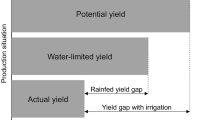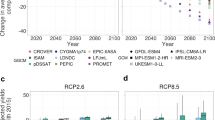Abstract
Potential economic impacts of future climate change on crop enterprise net returns and annual net farm income (NFI) are evaluated for small and large representative farms in Flathead Valley in Northwest Montana. Crop enterprise net returns and NFI in an historical climate period (1960–2005) and future climate period (2006–2050) are compared when agricultural production systems (APSs) are adapted to future climate change. Climate conditions in the future climate period are based on the A1B, B1, and A2 CO2 emission scenarios from the Intergovernmental Panel on Climate Change Fourth Assessment Report. Steps in the evaluation include: (1) specifying crop enterprises and APSs (i.e., combinations of crop enterprises) in consultation with locals producers; (2) simulating crop yields for two soils, crop prices, crop enterprises costs, and NFIs for APSs; (3) determining the dominant APS in the historical and future climate periods in terms of NFI; and (4) determining whether NFI for the dominant APS in the historical climate period is superior to NFI for the dominant APS in the future climate period. Crop yields are simulated using the Environmental/Policy Integrated Climate (EPIC) model and dominance comparisons for NFI are based on the stochastic efficiency with respect to a function (SERF) criterion. Probability distributions that best fit the EPIC-simulated crop yields are used to simulate 100 values for crop yields for the two soils in the historical and future climate periods. Best-fitting probability distributions for historical inflation-adjusted crop prices and specified triangular probability distributions for crop enterprise costs are used to simulate 100 values for crop prices and crop enterprise costs. Averaged over all crop enterprises, farm sizes, and soil types, simulated net return per ha averaged over all crop enterprises decreased 24% and simulated mean NFI for APSs decreased 57% between the historical and future climate periods. Although adapting APSs to future climate change is advantageous (i.e., NFI with adaptation is superior to NFI without adaptation based on SERF), in six of the nine cases in which adaptation is advantageous, NFI with adaptation in the future climate period is inferior to NFI in the historical climate period. Therefore, adaptation of APSs to future climate change in Flathead Valley is insufficient to offset the adverse impacts on NFI of such change.






Similar content being viewed by others
References
Adams RM, Rosenzweig C, Peart RM, Ritchie JT, McCarl BA, Glyer JD, Curry RB, Jones JW, Boote KJ, Allen LH Jr (1990) Global climate change and US agriculture. Nature 345:219–224
Anderson JR, Dillon JL (1992) Risk analysis in dryland farming systems. Farm systems management series No. 2. Food and Agriculture Organization, Rome
Antle JM, Capalbo SM, Hewitt J (1999) Testing hypotheses in integrated impact assessments: climate variability and economic adaptation in Great Plains agriculture. National Institute for Global Environmental Change, Nebraska Earth Science Education Network, University of Nebraska, Lincoln, NE, pp T5-4 and 21
Antle JM, Capalbo S, Elliott E, Paustian KH (2004) Adaptation, spatial heterogeneity, and the vulnerability of agricultural systems to climate change and CO2 fertilization: an integrated assessment approach. Climatic Change 64:289–315
Brown RA, Rosenberg NJ (1997) Sensitivity of crop yield and water use to change in a range of climatic factors and CO2 concentrations: a simulation study applying EPIC to the central USA. Agricultural and Forest Meteorology 83:171–203
Chen C, Jackson G, Neill K, Miller J (2006) Spring Pea, Lentil, and Chickpea Response to Phosphorus Fertilizer. Fertilize Facts. No 38. Montana State University Agricultural Extension Service, Bozeman, Montana. http://landresources.montana.edu/FertilizerFacts/ (March 2009)
Deekshatulu B, Krishnan LR, Jacob N (1999) Spatial analysis and modeling techniques-a review. Geo-informatics: beyond 2000. An international conference on geo-informatics for natural resource assessment, monitoring and management, Indian Institute of Remote Sensing, Dehradun, India, March 9–11
Djokic D (1993) Towards general purpose spatial decision support systems using existing technologies. Proceedings of the second international conference/workshop on integrating geographic information systems and environmental modeling. Breckenridge, CO, September 26–30
Easterling WE III, Hurd BH, Smith JB (2004) Coping with global climate change: the role of adaptation in the United States. Pew Center on Global Climate Change, Arlington, VA
Engel R (1997) Response of Oat to Water and Nitrogen. Fertilize Facts No 15. Montana State University Agricultural Extension Service, Bozeman, Montana. http://landresources.montana.edu/FertilizerFacts/ (March 2009)
Flathead County Planning and Zoning Office (2009) Flathead county growth policy, Chap. 2: land uses. http://flathead.mt.gov/planning_zoning/growthpolicy/Chapter%202%20April%2010.pdf (January 2009)
Hardaker JB, Richardson JW, Lien G, Schumann KD (2004) Stochastic efficiency analysis with risk aversion bounds: a simplified approach. Australian Journal of Agricultural and Resource Economics 48:253–270
Hungerford RD, Nemani RR, Running SW, Coughlan JC (1989) MTCLIM A Mountain Microclimate Simulation Model, USDA Forest Service, Research Paper INT-414
Inkley DB, Anderson MG, Blaustein AR, Burkett VR, Felzer B, Griffith B, Price J, Root TL (2004) Global climate change and wildlife in North America. Technical review 04-2. The Wildlife Society, Bethesda, MD
Intergovernmental Panel on Climate Change (2007) Climate Change 2007: synthesis report. Cambridge University Press, UK. http://www.ipcc.ch/ipccreports/ar4-syr.htm (June 2008)
Izaurralde RC, Rosenberg NJ, Brown RA, Allison JR, Thomson AM (2003) Integrated assessment of Hadley Centre (HadCM2) climate-change impacts on agricultural productivity and irrigation water supply in the conterminous United States. Part II. Regional agricultural production in 030 and 095. Agricultural and Forest Meteorology 117:97–122
Izaurralde RC, Williams JR, McGill WB, Rosenberg NJ, Quiroga Jakas MC (2006) Simulating soil C dynamics with EPIC: model description and testing against long-term data. Ecological Modelling 192:362–384
Kaiser HM, Riha SJ, Wilks DS, Rossiter DG, Sampath F (1993) A farm-level analysis of economic and agronomic impacts of gradual climate warming. American Journal of Agricultural Economics 75:387–398
Kimball JS, Running SW, Nemani R (1997) An improved method for estimating surface humidity from daily minimum temperature. Agricultural and Forest Meteorology 85:87–98
Loucks DP (1995) Developing and implementing decision support systems: a critique and challenge. Water Resources Bulletin 31:571–582
Maurer EP (2007) Uncertainty in hydrologic impacts of climate change in the Sierra Nevada, California under two emissions scenarios. Climatic Change 82:309–325
McCarthy JJ, Canziani OF, Leary NA, Dokken DJ, White KS (eds) (2001) Climate change 2001: impacts, adaptation, and vulnerability. Intergovernmental panel on climate change, Cambridge University Press, UK
McGinn SM, Toure A, Akinremi OO, Major DJ, Barr AG (1999) Agroclimate and crop response to climate change in Alberta, Canada. Outlook on Agriculture 28:19–28
McKinney MS, Easterling WE, Rosenberg NJ (1992) Simulation of crop productivity and responses to climate change in the year 2030: the role of future technologies, adjustments and adaptations. Agricultural and Forest Meteorology 59:103–127
Meehl GA, Stocker TF, Collins WD, Friedlingstein P, Gaye AT, Gregory JM, Kitoh A, Knutti R, Murphy JM, Noda A, Raper SCB, Watterson IG, Weaver AJ, Zhao Z-C (2007a) Global climate projections. In: Solomon S, Qin D, Manning M, Chen Z, Marquis M, Averyt KB, Tignor M, Miller HL (eds) Climate change 2007: the physical science basis. Contribution of Working Group I to the Fourth Assessment Report of the Intergovernmental Panel on Climate Change. Cambridge University Press, Cambridge, UK
Meehl GA, Covey C, Delworth T, Latif M, McAvaney B, Mitchell JFB, Stouffer FJ, Taylor KE (2007b) The WCRP CMIP3 multimodel dataset: a new era in climate change research. Bulletin of the American Meteorological Society 88:1383–1394
Montana Agricultural Statistics Service (2008) Montana agricultural statistics book (Economic). http://www.nass.usda.gov/Statistics_by_State/Montana/Publications/Annual_Statistical_Bulletin/index.asp (February 2009)
Montana Agricultural Statistics Service (2009) County Profiles. Flathead County. http://www.nass.usda.gov/Statistics_by_State/Montana/Publications/county/profiles/2007/C07029.HTM (January 2009)
Montana Department of Labor and Industry (2009) Demographic and Economic Information for Flathead County. Research and Analysis Bureau. http://www.ourfactsyourfuture.org/admin/uploadedPublications/3369_CF09_Flathead.pdf (March 2009)
Muehlbauer F (2007) Spring Lentil Western Yield Trial—2006. Northwest Agricultural Research Center, Montana State University, Bozeman, MT
National Research Council (2001) Climate change science: an analysis of some key questions. Committee on the science of climate change, National Academy Press, Washington, DC
Raupach MR, Marland G, Ciais P, Le Quéré C, Canadell JG, Klepper G, Field CB (2007) Global and regional drivers of accelerating CO2 emissions. Proceedings of the National Academy of Sciences 104:10288–10293
Reilly JM (2002) Agriculture: the potential consequences of climate variability and change. A report of the National Agriculture Assessment Group for the U.S. Global Change Research Program. Cambridge University Press, UK
Richardson JW, Schumann KD, Feldman PA (2006) Simetar: simulation and econometrics to analyze risk. College Station, TX. http://www.simetar.com/Browser.aspx (accessed January 2009)
Santa Clara University (2008) Statistically Downscaled WCRP CMIP3 Climate Projections. http://gdo-dcp.ucllnl.org/downscaled_cmip3_projections/ (February 2009)
Smit B, Burton I, Klein R, Wandel J (2000) An anatomy of adaptation to climate change and variability. Climatic Change 45:223–251
Smith JB (2004) A synthesis of potential climate change impacts on the U.S. Pew Center on Global Climate Change, Arlington, VA
Spittlehouse DL, Stewart RB (2003) Adaptation to climate change in forest management. BC Journal of Ecosystems and Management 4:7–17. http://www.forrex.org/jem/archiveVol4iss1.asp (March 2008)
Stewart RB, Wheaton E, Spittlehouse DL (1998) Climate change: implications for the boreal forest. In: Legge AH, Jones LL (eds) Emerging air issues for the 21st century: the need for multidisciplinary management. Air and Waste Management Association, Pittsburg, PA, pp 86–101
Stougaard B (2007) Montana Statewide Spring Oat Variety Trial—2006. Northwest Agricultural Research Center, Montana State University, Creston, Montana. http://ag.montana.edu/nwarc/research/VarietyEvaluation/VarietyEvaluation.htm (March 2009)
Sugumaran R (2002) Development of a range management decision support system using remote sensing, GIS and knowledge based system. Computations and Electronics in Agriculture 37:199–205
Sugumaran R, Meyer J, Davis J (2004) A web-based environmental decision support system (WEDSS) for environmental planning and watershed management. Journal of Geographical Systems 6:1–16
Walther G-R, Post E, Convey P, Menzel A, Parmesan C, Beebee TJC, Fromentin J-M, Hoegh-Guldberg O, Bairlein F (2002) Ecological responses to recent climate change. Nature 416:389–395
Wang G, Schimel D (2003) Climate change, climate modes, and climate impacts. Annual Review of Environment and Resources 28:1–28
Wen G, Chen C, Neill K, Wichman D, Jackson G (2006) Phosphorus fertilizer needed in winter pea and lentil production in central Montana? Fertilize Facts No 40. Montana State University Agricultural Extension Service, Bozeman, Montana. http://landresources.montana.edu/FertilizerFacts/ (March 2009)
Williams JR, Jones CA, Kiniry JR, Spanel DA (1989) The EPIC crop growth model. Transactions of the ASAE 32:497–511
Wood AW, Maurer EP, Kumar A, Lettenmaier DP (2002) Long-range experimental hydrologic forecasting for the eastern United States. Journal of Geophysical Research: Atmospheres 107:4429
Wood AW, Leung LR, Sridhar V, Lettenmaier DP (2004) Hydrologic implications of dynamical and statistical approaches to downscaling climate model outputs. Climatic Change 15:189–216
Acknowledgments
The research reported here was supported in part by the National Research Initiative of the USDA Cooperative State Research, Education and Extension Service, grant number 2006-55101-17129. We acknowledge the Program for Climate Model Diagnosis and Intercomparison (PCMDI) and the WCRP’s Working Group on Coupled Modelling (WGCM) for their roles in making available the WCRP CMIP3 dataset. Support of this dataset is provided by the Office of Science, U.S. Department of Energy. Any use of trade, product, or firm names is for descriptive purposes only and does not imply endorsement by the U.S. Government.
Author information
Authors and Affiliations
Corresponding author
Rights and permissions
About this article
Cite this article
Prato, T., Zeyuan, Q., Pederson, G. et al. Potential Economic Benefits of Adapting Agricultural Production Systems to Future Climate Change. Environmental Management 45, 577–589 (2010). https://doi.org/10.1007/s00267-010-9427-0
Received:
Accepted:
Published:
Issue Date:
DOI: https://doi.org/10.1007/s00267-010-9427-0




